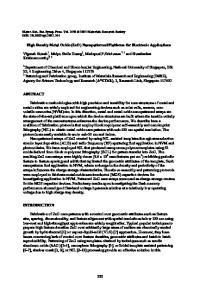Oxide Reduction in Advanced Metal Stacks for Microelectronic Applications
- PDF / 855,463 Bytes
- 6 Pages / 612 x 792 pts (letter) Page_size
- 26 Downloads / 411 Views
E6.33.1
Oxide Reduction in Advanced Metal Stacks for Microelectronic Applications Wentao Qin, Alex A. Volinsky1, Dennis Werho, N. David Theodore DigitalDNATM Labs, Motorola Inc., Tempe, AZ 85284, USA 1
Department of Mechanical Engineering, University of South Florida
ABSTRACT: Aluminum and copper are widely used for microelectronic interconnect applications. Interfacial oxides can cause device performance degradation and failure by significantly increasing electrical resistance. Interfacial oxide layers found in Al/Ta and Ta/Cu metal stacks were studied using Transmission Electron Microscopy (TEM) combined with Energy Dispersive Spectroscopy (EDS) and Parallel Electron Energy Loss Spectroscopy (PEELS). The analysis indicates that the observed interfacial oxide layers, Al2O3 and mainly Ta2O5, result from spontaneous reductions of Ta oxide and Cu oxide, respectively. Thermodynamics enables interpretation of the results. INTRODUCTION: Advanced metallization schemes are commonly used for microelectronic manufacturing. For high-performance integrated circuits, the semiconductor industry has made a switch from Al/SiO2 to Cu/low-k dielectric metallization; however, lower performance chips still utilize Al metallization, and some applications use both Cu and Al in the same chip. For instance, Al can be used to make a process compatible with previously existing wire-bonding and packaging schemes. It can also be used for metallization of top layers to protect the underlying Cu from oxidation. In the metallization process, oxidation of individual film surface can lead to further reactions and will ultimately affect physical properties of the stack, such as the electrical conductivity, wettability, and adhesion. Some of the effects are beneficial to the device performance, while others are detrimental. It is therefore important to understand, control and utilize such oxidation. Concerning the oxidations of Al, Ti and Si, both Al and Ti have a higher affinity for oxygen than Si does. As a result, when either Al or Ti is deposited on SiO2, it can reduce the underlying SiO2 [1-6]. A similar behavior has been reported for metal, metal-oxide interfaces in powders [7]. Reduction of surface oxides has been found to correlate with wettability, and eventually the enhancement of adhesion in different metal-oxide systems [8, 9]. For instance, metals with higher oxygen affinity showed higher wettabilities in the case of metal-TiO interfaces [10]. This eventually resulted in an improved adhesion. In Ti/GaAs and Ti/Si systems, the presence of high oxygen concentrations has been found to result in increased adhesion [11]. This paper reports analyses of interfacial oxides in Al/Ta and Ta/Cu stacks, discussions of the corresponding oxide reductions and process modifications. The physical property of concern is the electrical conductivities of the stacks.
E6.33.2
EXPERIMENTAL DETAILS: The metal film-stacks were deposited on Si wafers. In the case of the Al/Ta stack, the Ta deposition was followed by that of Al. Surface of the Ta layer was
Data Loading...








